
Flora and fauna of Canada main species

The flora and fauna of Canada it corresponds to the biological kingdom of the Holartic, dominated by a climate that goes from the arctic north to the temperate one in the south. Canada located at the northern end of the American continent, is the second largest country in the world, with 9,984,670 kmtwo.
This vast expanse ranges from the Pacific coasts in the west to the Atlantic in the east, reaching the Arctic Ocean in the north. Under these conditions, Canada has a great biodiversity with about 70,000 species of plants and animals.
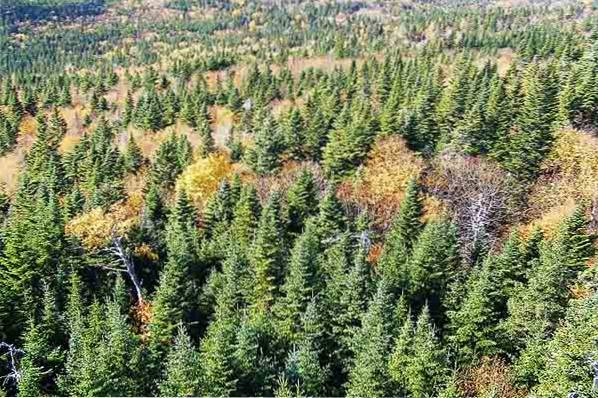
This variety of life is distributed in diverse terrestrial and marine biomes such as tundra and taiga to the north, mixed forests, deciduous angiosperm forests and grasslands to the south. While in its aquatic ecosystems the lakes and rivers stand out, as well as those corresponding to the three oceans that bathe its coasts..
Its flora is rich in conifers such as pines and firs, and temperate angiosperms such as maple, oak and elm. In addition, the beaver, the elk, the bear, the wolf and the Canada goose are characteristic members of its fauna..
Article index
- 1 Flora of Canada
- 1.1 Fir (Abies spp.)
- 1.2 Douglas fir (Pseudotsuga menziesii)
- 1.3 Red maple or Canada maple (Acer rubrum)
- 1.4 American chestnut (Castanea dentata)
- 1.5 Canadian mint (Mentha canadensis)
- 1.6 Elm (Ulmus spp.)
- 1.7 Pines (Pinus spp.)
- 1.8 Oak trees (Quercus spp.)
- 1.9 Tamarack (Larix laricina)
- 1.10 Slippers (Cypripedium spp.)
- 2 Fauna of Canada
- 2.1 Moose (Alces alces)
- 2.2 Rubber boa (Charina bottae)
- 2.3 Musk ox (Ovibos moschatus)
- 2.4 Caribou or reindeer (Rangifer tarandus)
- 2.5 Canadian beaver (Castor canadensis)
- 2.6 Canada Goose (Branta canadensis)
- 2.7 Canada lynx (Lynx spp.)
- 2.8 Gray wolf (Canis lupus)
- 2.9 Brown bear (Ursus arctos)
- 2.10 Polar fox (Vulpes lagopus)
- 3 References
Flora of Canada
Fir tree (Abies spp.)
Canada is home to several species of these coniferous trees, including the Pacific silver fir (Abies amabilis). As well as balsam fir (Abies balsamea) and the great fir (Abies grandis).
They are evergreen linear-leaved trees, which can reach a height of up to 72 m and a trunk diameter of 1.2 to 2 m. They have a very resinous light gray bark and their reproductive structures are erect cones or strobili.
Douglas fir (Pseudotsuga menziesii)
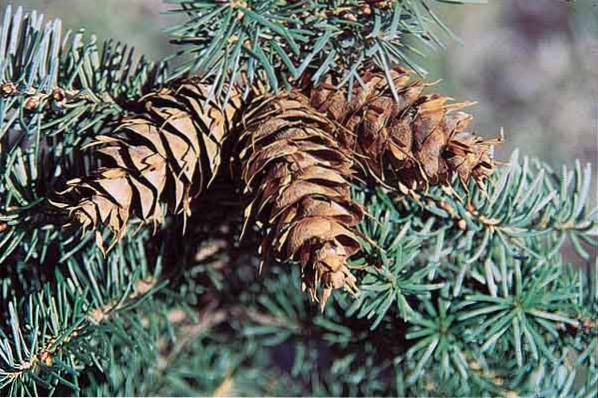
This coniferous tree, although they call it fir, belongs to a different genus from the firs themselves. It has a conical crown that reaches the height of up to 100 m and a trunk diameter of 2.4 m.
Unlike true firs, female cones are pendulous with persistent scales accompanied by a three-pointed bract..
Red maple or Canada maple (Acer rubrum)
To this species belongs the leaf that occupies the center of the Canadian flag, in such a way that it is the national tree. It is a tree that reaches up to 40 m in height, with about 88 to 150 cm of trunk diameter.
It is a deciduous species with leaves up to 11 cm long with 3 to 5 lobes with serrated edges. By fall the leaves turn red, yellow or orange before falling for the winter.
The flowers appear in spring directly from the branches and are bright red. On the other hand, a sweet syrup is prepared from the sap of this tree, called Maple syrup or maple syrup..
American chestnut (Castanea dentata)
It is a deciduous tree of the Fagaceae family, which can reach up to 30 m in height and 3 m in diameter. However, nowadays it is difficult to get trees of such dimensions, due to the disease of chestnut blight from Asia.
They have oval-shaped leaves and attenuated tips, with serrated margins, with more widely spaced and larger teeth compared to other chestnut trees. Its fruit is composed, forming a spiny green capsule (calibium) that bears 3 walnuts (chestnuts) that are consumed raw or preferably toasted or roasted.
Canadian mint (Mentha canadensis)
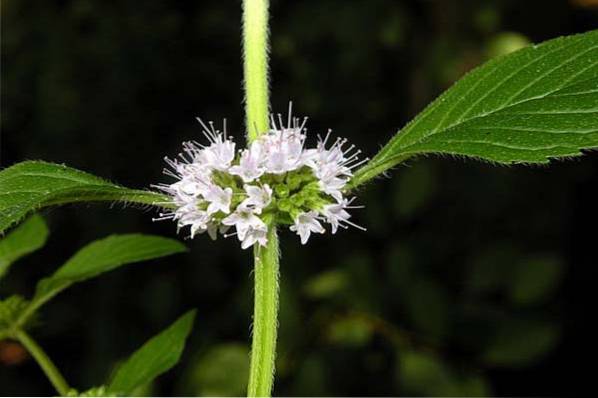
This plant of the Lamiaceae family is a perennial herb with underground rhizomes or stems. Its leaves are lanceolate opposite green with violet hues and its light purple flowers are borne in clusters at the bases of the leaves..
This plant is common in mountain meadows and in the understory of mixed and deciduous angiosperm forests. Its leaves give off the characteristic smell of mint.
Elm (Ulmus spp.)
Three species of elm inhabit Canada, the American elm (Ulmus americana), the slippery elm (Ulmos rubra) and rock elm (Ulmus thomasii). These are deciduous trees belonging to the ulmaceae family.
A specimen of American elm known as Sauble elm grew for 267 years on the banks of the Sauble River in Ontario. This tree reached 43 m in height and 196 cm in trunk diameter, before being felled for suffering from Dutch elm disease.
Pine trees (Pinus spp.)
In Canada there is a diversity of pines, including the red pine (Pinus resinosa), ponderosa pine (Pinus ponderosa) and western white pine (Pinus monticola). These coniferous trees reach heights of 35 m in the resinous pine, up to 70 m or more in the western white pine and the ponderosa pine.
Oak trees (Quercus spp.)
Oak trees are characteristic species of deciduous angiosperm forests, as well as mixed angiosperm and coniferous forests. Various species of oak are found in Canada, including the Chinquapin oak (Quercus muehlenbergii), strawberry oak (Quercus macrocarpa) and swamp white oak (Quercus bicolor).
Some species like the Chiquapin oak can grow as a shrub or as a tree, others are trees up to 50 m like the strawberry oak. Its fruits called acorns serve as food for wildlife, the largest being those of the strawberry oak.
Tamarack (Larix laricina)
This is a medium-sized deciduous coniferous tree endemic to North America, reaching 20 m in height and 60 cm in trunk diameter. The leaves are linear, very narrow, bluish-green in color and in clusters of up to 20 leaves..
The bark is scaly pinkish or reddish brown and the cones are no more than 2 cm deep reddish brown. These trees reach the limit of Arctic trees, since they can withstand temperatures down to -65 ºC.
Sneakers (Cypripedium spp.)
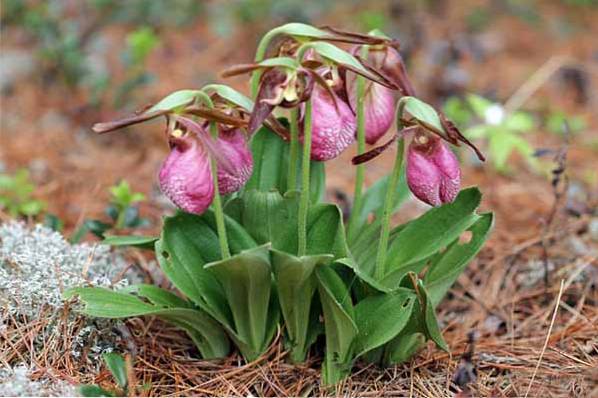
In Canada there are numerous species of terrestrial orchids, especially of the genus Cypripedium. They are called slippers because of the peculiar shape of their flowers, similar to slippers such as the pink women's shoe (Cypripedium acaule).
Other species are the small white slipper for women (Cypripedium candidum) and the mountain shoe (Cypripedium montanum).
They are perennial herbs due to their short rhizomes or underground stems and their habitat extends to the harsh conditions of the tundra. The colors of the flowers vary from pink to white, being reddish brown with white in the mountain shoe..
Fauna of Canada
I raised (Moose moose)
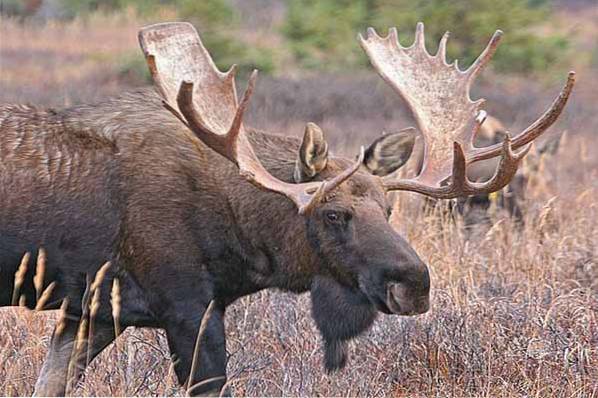
It is the largest species of the deer family, reaching up to 3 m in length and 2 m in height. The males are larger than the female, with a weight of up to 700 kg and their antlers reach 2 m apart, presenting flat areas that bifurcate in several series..
Their snout extends into a short trunk and they have a dewlap below the neck. In the muzzle, the column for breathing is separated from the column for smell, in order to block the former when swimming..
They have a magnificent sense of smell and a double coat, with a woolly undercoat and an upper layer of long hair. Their diet consists of aquatic plants, terrestrial herbs, and birch and willow buds..
In Canada, 3 of the 8 subspecies of moose exist, being Moose alces gigas the largest. The other subspecies are the Moose alces andersoni and the Moose alces americana.
Rubber boa (Charina bottae)
It is the only species of snake of the group of boas that inhabits North America and that in Canada is found in British Columbia. This snake is just over 80 cm long, being the smallest boa in the world.
Its common name derives from its smooth, shiny skin that gives it a rubbery appearance. While its color varies from dark brown to chestnut with pink tones and even olive green.
Musk ox (Ovibos moschatus)
Despite its common name, it is an animal related to sheep and goats and not to oxen. It inhabits the Arctic area, having become extinct in Europe, Asia and Alaska, being restricted to Canada and Greenland. It is a large mammal, up to 2.3 m in length, 1.5 m in height and 400 kg in weight.
It has a double layer of dark brown hair, an internal layer of dense short hairs and an external layer of long woolly hairs. The outer layer of hair is elongated covering halfway up the legs and they have a pair of lateral horns curved downwards and forwards.
Caribou or reindeer (Rangifer tarandus)
It belongs to the deer family characteristic of the tundra and taiga, with both migratory and sedentary habits. In Canada there are 6 of the 15 subspecies of reindeer, being towards Quebec and Labrador the subspecies caboti or the labrador caribou and to the south the typical subspecies of the boreal forest Rangifer tarandus caribu.
In the Yukon there is Grant's caribou or porcupine caribou (subsp. Grantii) and further north towards the arctic coasts and islands the caribou groenlandicus and the pearyi. Finally, the Osborn caribou (subsp. Osborni) is found in the forests of British Columbia.
Canadian beaverCastor canadensis)
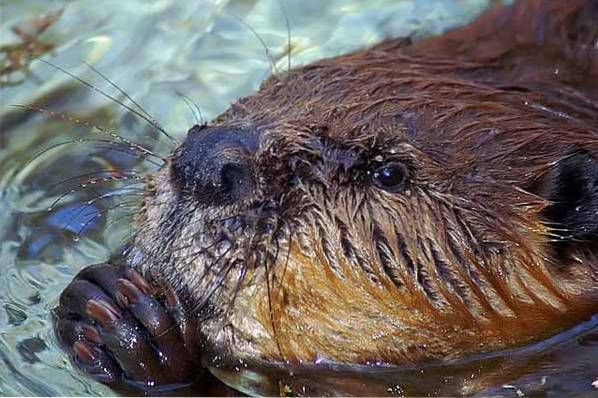
It is a semi-aquatic rodent that lives in the rivers and ponds of North America, reaching a length of 80 cm and 32 kg in weight. It has a dense, water-insulating dark brown coat, a paddle-shaped tail, and small black ears..
It has large front teeth that allow it to cut nearby trees to build dams in rivers and ponds. These dikes serve as a burrow and make up small dams where it lives.
In Canada it is a symbol, showing a figure called the beaver mother in the Tower of Peace in the Canadian Parliament holding a shield indicative of Canadian ethnicities.
Canada goose (Branta canadensis)
It is a goose with a greyish brown body with faint white lines, with a black head and neck, a white belly and a black tail. As well as a white band from the sides of the base of the head to the chin.
It inhabits arctic areas and reaches up to 110 cm in length, 185 cm in wingspan, and a weight in males of up to 6.5 kg.
Canada Lynx (Lynx spp.)
In Canada there are two species of lynx, the bobcat (Lynx rufus) and the Canadian lynx (Lynx canadensis). The former has reddish brown to gray fur, black spots and black ears, and inhabits the boreal forests of southern Canada.
Lies that Lynx canadensis inhabits the taiga and tundra of Alaska and Canada, presenting yellowish or very light brown fur with dark spots and black ears.
Grey Wolf (Canis lupus)
The wolf is a characteristic carnivore of the forests and tundras of the northern hemisphere, where it lives in packs controlled by an alpha male and female. They reach approximately 160 cm long, 85 cm high and 40 kg in weight, with a coat of white, gray, brown to black..
In Canada there are about 60,000 wolves, those of the Arctic have totally white fur, while those of the south are gray.
Grizzly (Ursus arctos)
This large omnivorous mammal inhabits boreal forests, as well as mixed and deciduous forests. They feed on vegetables, insects, small vertebrates, fish and honey.
In this way they prepare for the period of hibernation, which is a state of lethargy during winter. They can reach almost 3 m in length, a height of 1.5 m and a weight of up to 675 kg, depending on the subspecies.
The color of the coat is variable between dark brown almost black, gray and yellowish brown. In Canada there is one of the largest subspecies, the grizzly or gray bear (Ursus arctos horribilis).
Polar fox (Vulpes lagopus)
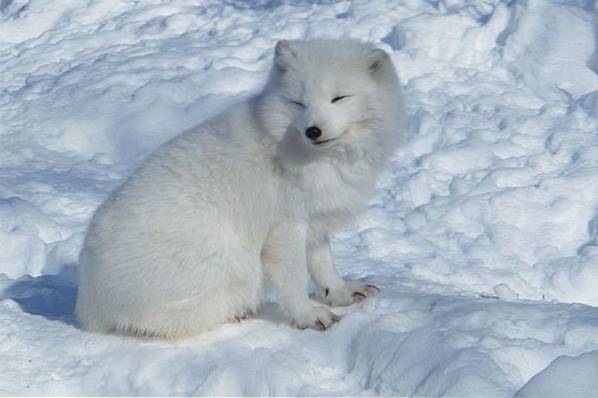
It is a small fox with abundant white to bluish fur that inhabits the entire Arctic region from Eurasia to North America. They reach up to 68 cm in length plus 30 cm of tail, with about 30 cm in height and up to 3.5 kg in weight.
Their diet consists mainly of small mammals, birds, and fish, although they can also eat carrion, fruits, and insects. In Canada they are found to the north in the tundra and taiga, reaching the south as far as Hudson Bay.
References
- Asociation FNA. Flora of North America (FNA). (As seen on June 17, 2020). beta.floranorthamerica.org
- Douglas, GW, GB Straley, DV Meidinger and J. Pojar (Editors) (1998-1999). Illustrated flora of British Columbia. B.C. Min. Environ., Lands and Parks, and B.C. Min. For., Victoria, B.C. 8 volumes.
- E-Fauna BC. Electronic Atlas of the Wildlife of British Columbia. (Viewed June 16, 2020). ibis.geog.ubc.ca
- Rodenhouse, N.L., Christenson, L.M., Parry, D. and Green, L.E. (2009). Climate changes effects on native fauna of northeastern forests. Canadian Journal of Forest Research.
- Scudder, G.G.E. (1979). Present patterns in the fauna and flora of Canada. Memoirs of the Entomological Society of Canada.
- World Wild Life (Viewed on June 16, 2020). worldwildlife.org



Yet No Comments